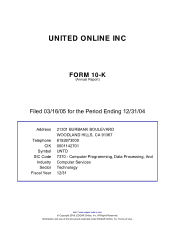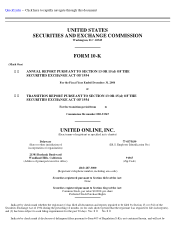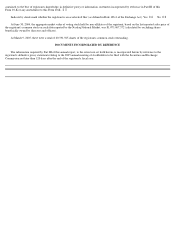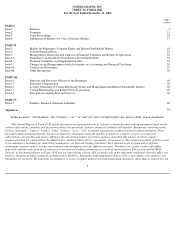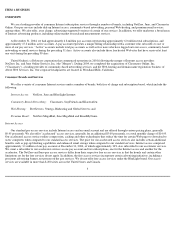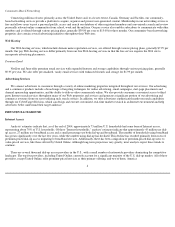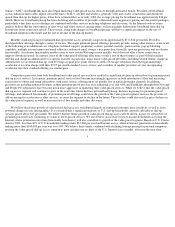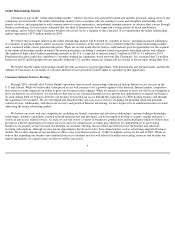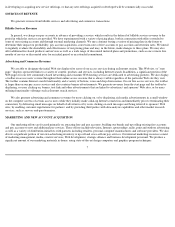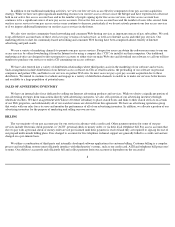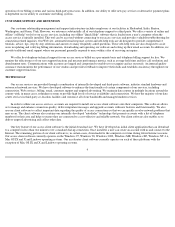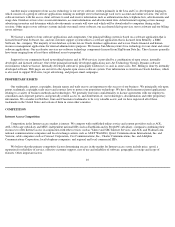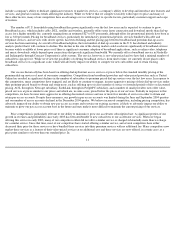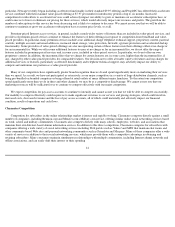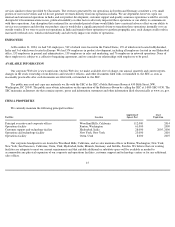Classmates.com 2004 Annual Report Download - page 7
Download and view the complete annual report
Please find page 7 of the 2004 Classmates.com annual report below. You can navigate through the pages in the report by either clicking on the pages listed below, or by using the keyword search tool below to find specific information within the annual report.
Online ("AOL") and EarthLink, have also begun marketing value-priced access services through alternative brands. Providers of broadband
access, which includes cable, digital subscriber lines ("DSL"), satellite and wireless, generally offer users faster connections and download
speeds than dial-up for higher prices. It has been estimated that, as of early 2004, the average pricing for broadband was approximately $44 per
month. However, broadband pricing has been declining and a number of providers offer much more aggressive pricing and discounted packages,
particularly when their access offerings are combined with other services including telephone and television. As the Internet evolves, many
analysts believe that the convergence of data, voice and video services, among others, will increasingly differentiate broadband from dial-up
beyond just faster connection speeds. These trends, along with changes in broadband pricing, will have a significant impact on the rate of
broadband adoption in the future and the rate of decline of the dial-up market.
Monthly standard pricing for unlimited dial-up Internet access generally ranges from approximately $7 to $24 per month. Providers
distinguish their offerings through a variety of factors. The major premium-priced offerings generally provide, among other features, some or all
of the following at no additional cost: telephone technical support, proprietary content, parental controls, spam controls, pop-up blocking
capability, multiple account names and email addresses, enhanced email storage, virus protection, firewalls, spyware protection, and accelerator
functionality. Accelerator functionality enables users to view certain Web pages more quickly, but it does not offer a faster connection or
improve download speeds. In contrast, most of the value-priced offerings offer none or only a few of these features as part of their standard
offering and charge an additional fee for specific features. In particular, many major value-priced providers, including United Online, charge an
additional fee for accelerated dial-up, with $5 being a typical price point. However, AOL's Netscape subsidiary recently began marketing
accelerator at no extra charge with their $9.95 per month standard access service, and a number of smaller providers are also incorporating
accelerator into their standard offering at a similar price.
Competitive pressures from both broadband and value-priced services have resulted in significant declines in subscribers to premium-
priced
dial-up access services. In response, premium-priced services have become increasingly aggressive in both introductory offers and in pricing
concessions to obtain and retain subscribers, with some services offering up to six months free in particular market channels. In addition,
providers are including enhanced features in their premium-
priced services at no additional cost, and AOL and EarthLink, through their Netscape
and People PC subsidiaries, have become much more aggressive in marketing their value-priced services. While we believe that the value-priced
dial-up access segment will continue to grow in the near term, future declines in broadband pricing, declines in pricing for premium-priced
offerings, and enhanced functionality of premium-priced offerings could slow the growth of the value-priced segment, increase the pressure of
add-on pricing for accelerator or other services, or cause the segment to decline in the future. These factors could also result in price declines in
the value-priced segment, as well as increased use of free months and other discounts.
We believe that future growth of value-priced dial-up access will depend largely on continued consumer price sensitivity as well as from
potential changes in user demographics. It is estimated that a significant majority of U.S. dial-up households currently subscribe to dial-up
services priced above $15 per month. We believe that the future growth of value-priced dial-up access will be driven, in part, by subscribers of
premium-priced services continuing to switch to lower-priced services. We also believe an increase in lower-income households accessing the
Internet, where penetration rates have historically been lowest, will also contribute to growth of the value-priced segment. Based on U.S. Census
data for 2003, less than 46% of U.S. households making under $35,000 per year had Internet access, whereas Internet penetration in households
making more than $100,000 per year was over 90%. We believe these trends, combined with declining average pricing for personal computers,
position the value-priced dial-up access segment to grow and increase its share of the U.S. Internet access market, at least in the near term.
5

